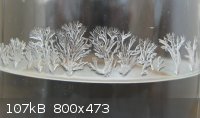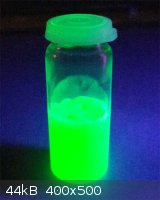| Pages:
1
..
7
8
9
10
11
..
40 |
blogfast25
International Hazard
    
Posts: 10562
Registered: 3-2-2008
Location: Neverland
Member Is Offline
Mood: No Mood
|
|

Some 20 g of copper (II) nitrate hydrate, on a plastic tea strainer. I believe it’s the hexahydrate but have yet to determine its MP. It was
obtained by dissolving 10 g conductor copper in 70 % nitric acid, then reducing the obtained solution by about a third, cooling, adding seed crystals,
then icing. Most of the solution then crystallised out. The blue is more intense to the naked eye than the photo promises.
Edit: It's been verified to be the hexahydrate: it melts way below 50 C and resolidifies on cooling.
[Edited on 11-10-2011 by blogfast25]
|
|
|
Wizzard
Hazard to Others
  
Posts: 337
Registered: 22-3-2010
Member Is Offline
Mood: No Mood
|
|
@blogfast- I agree, copper nitrate is much prettier than copper sulfate 
|
|
|
blogfast25
International Hazard
    
Posts: 10562
Registered: 3-2-2008
Location: Neverland
Member Is Offline
Mood: No Mood
|
|
Yeah, it's almost as deep blue as a copper (II) diammonia complex.
|
|
|
White Yeti
National Hazard
   
Posts: 816
Registered: 20-7-2011
Location: Asperger's spectrum
Member Is Offline
Mood: delocalized
|
|
macro photography
@blogfast25
Does your camera have macro capability? I find it makes a huge difference when taking pictures of chemicals. The symbol usually looks like a flower:

I'm asking because it looks like the picture is out of focus and it doesn't need to be.
This is not meant to be criticism, just constructive feedback
"Ja, Kalzium, das ist alles!" -Otto Loewi
|
|
|
Endimion17
International Hazard
    
Posts: 1468
Registered: 17-7-2011
Location: shores of a solar sea
Member Is Offline
Mood: speeding through time at the rate of 1 second per second
|
|
Hydrated copper(II) nitrate has one of the most beautiful blue crystals seen in labs. It's close to the beauty of tetraamminecopper(II) sulphate or
mercury tetrathiocyanatocobaltate(II).
The only problem is that it's very hygroscopic. Later this year I've made some and I've stored them wet in the bottle, but added an ampoule of sodium
hydroxide and quartz sand. Over the couple of months, that little sucker managed to suck in both the water and nitric acid residues, and even started
eflorescenting the nitrate salt, so I've removed it.
Sometimes when I look at them, I just want to eat them because they look so nice. 
Some people dry their crystals in desiccators, but I prefer finishing the job in the bottle. I just take/make an ampoule, put the mixture inside, and
stuff some cotton or rough cork (if possible). If the bottle is not tilted, the contents will be super dry in a matter of days. It's a neat way to
reduce the consumption of desiccant because the space available for vapors is very small, and if there are any other volatiles, they contaminate the
ampoule only.
It's neat for weighing, too.
|
|
|
MrHomeScientist
International Hazard
    
Posts: 1806
Registered: 24-10-2010
Location: Flerovium
Member Is Offline
Mood: No Mood
|
|
@blogfast25:
Beautiful crystals! I've got a solution of copper nitrate that was waste from the silver tree demo, and I've been evaporating it down but it just
refuses to crystallize. I don't have any seed crystals to initiate it either, any suggestions? I was going to try putting it in a dessicator bag and
see if that helps.
|
|
|
Bot0nist
International Hazard
    
Posts: 1559
Registered: 15-2-2011
Location: Right behind you.
Member Is Offline
Mood: Streching my cotyledons.
|
|
Any idea of the amount of salts in the solution. You have to boil it down until it is super saturated, then cool it slowly. A preheated thermos works
good for this. With copper sulfate I sometimes crash it out by adding cold ethanol, filter, and then redissolve in a small amount of boiling distilled
H<sub>2</sub>O before recrystallizing. Precipitating with ethanol won't work for copper nitrate though, as it is soluble in alcohol.
[Edited on 13-10-2011 by Bot0nist]
U.T.F.S.E. and learn the joys of autodidacticism!
Don't judge each day only by the harvest you reap, but also by the seeds you sow.
|
|
|
Endimion17
International Hazard
    
Posts: 1468
Registered: 17-7-2011
Location: shores of a solar sea
Member Is Offline
Mood: speeding through time at the rate of 1 second per second
|
|
Copper nitrate is notorious for its will to stay in a solution. 
Large, well developed crystals are very hard to obtain. Desiccation would work, but it would require large amounts of desiccant with power of
desiccation greater than copper nitrate, and that really narrows it down because Cu-nitrate is one hell of a desiccator itself.
I've just put the desktop lamp under the evaporating dish and cover it with a bent piece of filter paper. Ventilation is neccessary because of excess
nitric acid.
I've forgot about it and later found it dehydrated. That happened 3-4 times in a row (I know, I'm lazy), but I've managed to get them, eventually.
They're tiny and clumped together.
You just need to remove as much water as you can, and then the whole solution turns solid in a few seconds, as it cools down. Basically, something
similar to sodium acetate.
Later, drying with NaOH in a sealed space is neccessary because there's always some water that didn't end up in the crystal lattice.
[Edited on 13-10-2011 by Endimion17]
|
|
|
Wizzard
Hazard to Others
  
Posts: 337
Registered: 22-3-2010
Member Is Offline
Mood: No Mood
|
|
I had soem very lovely copper nitrate crystals from a solution, dried over a month by windowsill  Pics coming soon, I guess. Pics coming soon, I guess.
|
|
|
blogfast25
International Hazard
    
Posts: 10562
Registered: 3-2-2008
Location: Neverland
Member Is Offline
Mood: No Mood
|
|
@White Yeti: thanks, I’m gonna try that!
@MrHomeScientist: try seed crystals and what Endimion said. Make seed crystals by dipping a glass rod in your solution, then gently evaporating the
water well above a Bunsen or other flame, making sure not to overheat. Sprinkle these into your solution. Bear in mind the fantastic solubility of
Cu(NO3)2: at 0 C it’s about 80 g/100 g of water, off the top of my head!
@Bot0nist: look up solubilities in Wikipedia solubility table.
@Endimion: right on the money.
|
|
|
Endimion17
International Hazard
    
Posts: 1468
Registered: 17-7-2011
Location: shores of a solar sea
Member Is Offline
Mood: speeding through time at the rate of 1 second per second
|
|
Hey, when we're already talking about beautiful salts, is there a thread at SM that deals with preparations of complex salts like the ones I've
mentioned earlier, tetraamminecopper(II) sulphate and mercury tetrathiocyanatocobaltate(II)?
Dithiocyanatobis(triphenylphosphine)nickel(II), hexaamminenickel(II) chloride, bisdimethylglioximatonickel(II) and potassium trisoxalatochromate(III)
come to mind, too.
Lots of complex salts are simply striking, with nice crystal shapes and vivid colors, and are relatively easy to prepare. Some exibit interesting
magnetic properties.
What I'm searching for is a thread where people were collecting the procedures.
|
|
|
blogfast25
International Hazard
    
Posts: 10562
Registered: 3-2-2008
Location: Neverland
Member Is Offline
Mood: No Mood
|
|
@Endi:
I don't recall it but try the search facility?
|
|
|
Endimion17
International Hazard
    
Posts: 1468
Registered: 17-7-2011
Location: shores of a solar sea
Member Is Offline
Mood: speeding through time at the rate of 1 second per second
|
|
I've tried, but it's not very helpful. Perhaps I'll open a new thread.
|
|
|
Neil
National Hazard
   
Posts: 556
Registered: 19-3-2008
Member Is Offline
Mood: No Mood
|
|
http://www.sciencemadness.org/talk/viewthread.php?tid=16646#...
http://www.sciencemadness.org/talk/viewthread.php?tid=16220#...
http://www.sciencemadness.org/talk/viewthread.php?tid=15513#...
http://www.sciencemadness.org/talk/viewthread.php?tid=11218#...

|
|
|
MrHomeScientist
International Hazard
    
Posts: 1806
Registered: 24-10-2010
Location: Flerovium
Member Is Offline
Mood: No Mood
|
|
Quote: Originally posted by blogfast25  | | @MrHomeScientist: try seed crystals and what Endimion said. Make seed crystals by dipping a glass rod in your solution, then gently evaporating the
water well above a Bunsen or other flame, making sure not to overheat. Sprinkle these into your solution. Bear in mind the fantastic solubility of
Cu(NO3)2: at 0 C it’s about 80 g/100 g of water, off the top of my head! |
Great idea, I'll give that a try. My initial solution of ~80mL was pretty dilute, since it was just leftovers from the silver tree demo, and has
evaporated down to just a few mL of dark blue liquid. I'll post here if the seed crystal method does the trick.
|
|
|
Endimion17
International Hazard
    
Posts: 1468
Registered: 17-7-2011
Location: shores of a solar sea
Member Is Offline
Mood: speeding through time at the rate of 1 second per second
|
|
You can also try an old lab trick - saturate the solution by evaporating over a heating pad, cool it down and then gently scratch the inside of the
vessel with a glass rod. That provokes a localized stress which helps creating crystals even without seeding.
|
|
|
Wizzard
Hazard to Others
  
Posts: 337
Registered: 22-3-2010
Member Is Offline
Mood: No Mood
|
|
I find a small sliver of wood put in and held in the meniscus works quite well. Between capillary action, the pressure difference localized to the
small point in the wood, and evaporative action driving more capillary action... Can't go wrong!
|
|
|
White Yeti
National Hazard
   
Posts: 816
Registered: 20-7-2011
Location: Asperger's spectrum
Member Is Offline
Mood: delocalized
|
|
This is a sodium bicarbonate solution I left on a shelf for too long. Nothing special, but pretty nonetheless.

I destroyed the crystals in attempt to improve the lighting and to insert a black background, sadly.
"Ja, Kalzium, das ist alles!" -Otto Loewi
|
|
|
MrTechGuy1995
Harmless

Posts: 27
Registered: 21-9-2011
Location: Chatham, New Jersey
Member Is Offline
Mood: Lab Envy
|
|
This is what I essentually used for my NOx Generator.

9Kv 30mA
|
|
|
blogfast25
International Hazard
    
Posts: 10562
Registered: 3-2-2008
Location: Neverland
Member Is Offline
Mood: No Mood
|
|
Large needles of oxalic acid (and that’s only the first crystallisation!) with a weak solution of trioxaloferrate (III)
(FeOx<sub>3</sub><sup>3-</sup> as supernatant liquid. At
low concentrations the trioxaloferrate complex is slightly fluorescent: as supernatant liquid. At
low concentrations the trioxaloferrate complex is slightly fluorescent:

|
|
|
Nick F
Hazard to Others
  
Posts: 439
Registered: 7-9-2002
Member Is Offline
Mood: No Mood
|
|
Hello everyone, this is uranyl nitrate hexahydrate (fused and cast into the vial so that there's no dust), fluorescing under long-wave UV.
It is a very bad photo because I don't know how to use my camera in low-light conditions, but I think the blur on the image emphasises the glow and
actually gives quite a nice effect  . .
Edit: I'm totally failing at uploading an image. Hang on a minute, I'll remember how to do it soon...
[Edited on 24-11-2011 by Nick F]
[Edited on 24-11-2011 by Nick F]

|
|
|
blogfast25
International Hazard
    
Posts: 10562
Registered: 3-2-2008
Location: Neverland
Member Is Offline
Mood: No Mood
|
|
Quote: Originally posted by Nick F  | Hello everyone, this is uranyl nitrate hexahydrate (fused and cast into the vial so that there's no dust), fluorescing under long-wave UV.
It is a very bad photo because I don't know how to use my camera in low-light conditions, but I think the blur on the image emphasises the glow and
actually gives quite a nice effect  . .
Edit: I'm totally failing at uploading an image. Hang on a minute, I'll remember how to do it soon...
[Edited on 24-11-2011 by Nick F]
[Edited on 24-11-2011 by Nick F] |
How much is there?
|
|
|
Bezaleel
Hazard to Others
  
Posts: 444
Registered: 28-2-2009
Member Is Offline
Mood: transitional
|
|
Nick, what source of UV/wavelength did you use?
|
|
|
White Yeti
National Hazard
   
Posts: 816
Registered: 20-7-2011
Location: Asperger's spectrum
Member Is Offline
Mood: delocalized
|
|
Quote: Originally posted by Nick F  | [...]
It is a very bad photo because I don't know how to use my camera in low-light conditions, but I think the blur on the image emphasises the glow and
actually gives quite a nice effect  . .
[...]
|
What I do in low light conditions is I set my camera down on a pile of books, (or on a tripod) and use the timer option to take a picture.
Here's why. In low light conditions, the camera needs to receive approximately the same amount of light as if it were taking a picture in daylight.
The result is a longer exposure length. So if you do so much as twitch during that interval, the picture is ruined.
Setting the camera down on a pile of books and using the timer ensures that the camera won't move when you're taking the picture.
But whatever you do, don't use flash
"Ja, Kalzium, das ist alles!" -Otto Loewi
|
|
|
Nick F
Hazard to Others
  
Posts: 439
Registered: 7-9-2002
Member Is Offline
Mood: No Mood
|
|
blogfast25, I have about 29g, the vial is 6.5cm tall.
Bezaleel, the UV source is a common 4W fluorescent tube type, the sort that is used to detect fake money. It looks like this:

I believe they peak at somewhere around 360nm. It is standing up just to the right of the image, its reflection can be seen near the top right of the
vial.
White Yeti, I don't even know if my camera has a timer option, it is quite old and was cheap when I bought it!
[Edited on 25-11-2011 by Nick F]
|
|
|
| Pages:
1
..
7
8
9
10
11
..
40 |